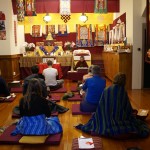The Practices
 Tibetan Buddhist Practices At The Centre
Tibetan Buddhist Practices At The Centre
Buddhists “take refuge” in, or to “go for refuge” to, the Three Jewels (aka the “Three Refuges”). This is done formally in lay and monastic ordination ceremonies or through practices that focus on the significance of:
• The Buddha
• The Dharma, the teachings
• The Sangha, the community of (or at least partially) enlightened beings, usually connected to the community of Buddhist monks and nuns.
Vajrayana practitioners visualise the “refuge tree” and is typically depicted on thangkas (scroll paintings) or murals. Regular preliminary practice sessions are held at Phuntsok Choeling that focus on these core Buddhist principles.
Chenrezig Practice generates compassion through the visualisation of Avalokiteshvara (Tibetan Chenrezig – the bodhisattva of compassion) and reciting the mantra OM MANI PADME HUM.
Samatha Meditation Sessions of Calm Abiding meditation, (aka Shamatha), are not a specifically Buddhist technique but is common to other spiritual traditions as well. Single-pointed concentration on the breath or other suitable object of meditation is a natural process that helps focus better on ordinary tasks and enables you to become more relaxed and at peace.
Ngondro Practices are the beginning or foundational practices of Tibetan Buddhism where the guru represents everything from the Buddha, the Dharma, the Sangha and is seen as the embodiment of everything through energies of the body, speech and mind. Practicing prostrations trains the body, speech and mind through purification that because of defilements, our channels or chakras can be blocked and with practice we can begin to realize our own true nature.
See sections on Retreats and Teachings for access to teaching sessions that will help develop the skills and understanding to participate in practices.

